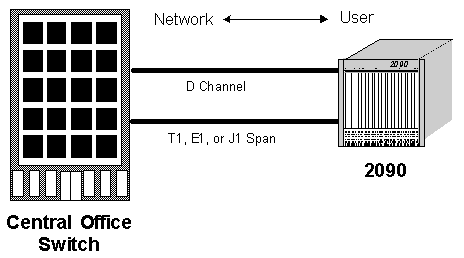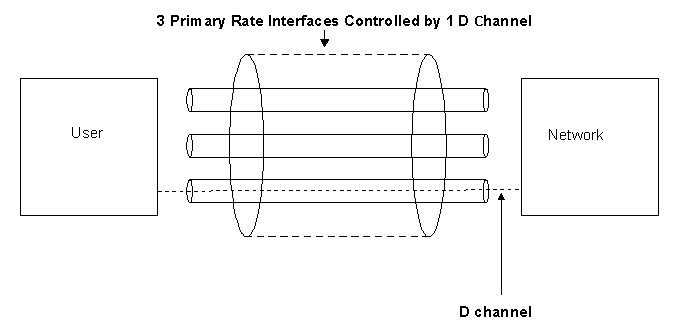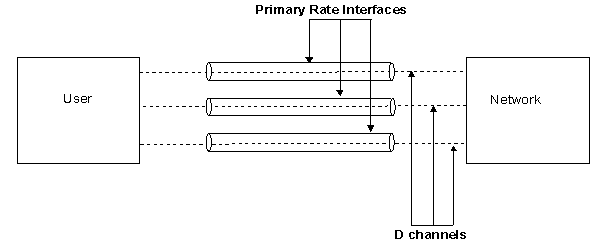
You are here: CSP Developer’s Guide: Common Channel Signaling > 8 ISDN > Introduction to ISDN

Overview
The Dialogic Integrated Services Digital Network (ISDN) product provides multiple communications tasking (voice, data, compressed),128 Kbps high-speed and high-bandwidth service. ISDN, non-compressed (512 KBps compressed) also provides on-demand service, connects up to eight devices simultaneously, and can be call-managed. The basic configuration is 23+D (Primary Rate Interface) and 30B+D outside of North America.
Description
The ISDN card, in conjunction with the T1 and E1 network interface cards, interfaces to various equipment types supporting the ISDN PRI protocol. These include tandem (Class 4) switches, end office (Class 5) switches, PBXs, and proprietary implementations, not only in North America but throughout the world.
Implementation
The Dialogic ISDN PRI implementation is based on ITU-T Q.921 and Q.931 specifications. Each implemented variant references the appropriate interface document supplied by the equipment manufacturer. The interface document is usually a variant of the ITU-T recommendations.
Since each manufacturer supports different services, the host manages the information to send and receive in specific messages. This lets you access many features and services at the host layer and carry them out using PPL-controlled call control logic.
Each ISDN card supports 32 D channels. Each D channel provides the High Data Link Control (HDLC) communications over T1 or E1 on one timeslot on the span. Each D channel can control up to 19 other spans in addition to the span on which it is located.
National ISDN PRI NI 2
The CSP system software ISDN stack supports National ISDN PRI NI 2. National ISDN PRI supports Non-Facility Associated Signaling (NFAS), allowing up to 30 DS1 interfaces and the D channel backup procedure, as well as B channel availability and provisioning. Connection endpoint variants are defined for National ISDN User side and Network side.
Diagram
The figure below shows an ISDN Point-to-Point Connection with an CSP connected to a central office switch.
Figure 8-1 ISDN Point-to-Point Connection

Customization
Depending upon the provisioning requirements, you can have one D channel per span [Facility Associated Signaling (FAS)], or one D channel managing up to 20 spans [Non-Facility Associated Signaling (NFAS)]. You can control a total of 32 spans using all FAS D channels, or up to 20 spans per NFAS D channel (to a maximum of 64 spans per system). You can intermix both FAS and NFAS D channels on a card with each supporting a different variant. NFAS spans can be configured dynamically during call processing.
You can insert multiple ISDN cards in any line card slot in the CSP. Each has unrestricted access to all timeslots, so you can configure any timeslot in the system as a D channel.
NFAS and FAS Examples
When using NFAS, the D channel on one span controls the B channels on other spans. However, with NFAS a backup D channel is assigned for redundancy on a separate span.
The figure below shows an example of NFAS Controlling three Primary Rate Interfaces (PRI).
Figure 8-2 Three Primary Rate Interfaces Controlled by 1 D channel

The figure below shows an example of NFAS with Backup D Channel Controlling three PRIs.
Figure 8-3 Three Primary Rate Interfaces Controlled by 1 backup D channel

When using FAS there is a D channel on the same span as a B channel that is controlled by the D channel. The figure below shows an example of FAS on each of three PRIs:
Figure 8-4 One D channel controls one B channel

Supported Features
ISDN cards supports the following:
• 32 D channels per-card over T1 or E1
• ITU-T Q.921, Q.931-based
• Euro-ISDN (Includes French and German Delta), JATE (INS 1500), Lucent 4ESS Q.931 PRI, Lucent 5ESS Q.931 PRI (Custom), Northern Telecom DMS-100 Q.931 PRI (Custom), Northern Telecom DMS-250 Q.931 PRI (Custom), and AUSTEL.
• Network Side Euro-ISDN, Network Side ISDN BRI - Lucent 4ESS
• D channel backup
• NFAS (Not supported over E1)
• Incoming B channel Negotiation
• Flexible Information Element (IE) reporting and parsing (with PPL messages)
• Card Level Redundancy
After Installing two ISDN cards with their appropriate I/O cards redundancy is provided for all 32 D channels. If the active card fails, or if you remove the card, the standby card takes over the call processing operations. All calls in a connected state are retained while others are purged.